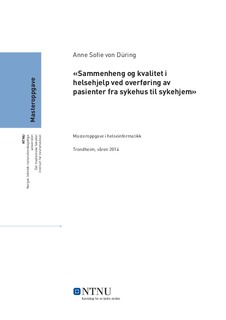| dc.contributor.advisor | Faxvaag, Arild | nb_NO |
| dc.contributor.author | von Düring, Anne Sofie | nb_NO |
| dc.date.accessioned | 2014-12-19T14:22:17Z | |
| dc.date.available | 2014-12-19T14:22:17Z | |
| dc.date.created | 2014-10-28 | nb_NO |
| dc.date.issued | 2014 | nb_NO |
| dc.identifier | 758684 | nb_NO |
| dc.identifier.uri | http://hdl.handle.net/11250/264362 | |
| dc.description.abstract | The report describes a study of the coherence and quality of health care when transferring patients from hospitals to nursing homes. The purpose of this study is to gain better insight into what is needed to offer patients continuity and quality of health care when a patient crosses the boundaries between hospital and nursing home. It is an objective that the findings of the study may form part of the knowledge platform for developing medical systems specialist health and health care services in the community.
The study was conducted using qualitative research methodology, observations, interviews and document studies. The observations were carried out in two stages at a nursing home in Oslo. The first stage was carried out at an intermediate section of the nursing home in autumn 2012, whose purpose was primarily to be familiar with the environment and experience how it is to be an observer. The second stage was completed in 2013 at the same intermediate section and on and another section where patients were admitted to the nursing home a short period of time. Interviews were conducted with nurses and doctors during this period. I had prepared a guidance interview guide. The document studies were carried out during the entire study period.
The study is showing communication challenges when transferring patients from hospital to nursing home. The information provided in advance of the transfer did not reflect the patient's condition upon arrival at the nursing home. The hospital and nursing home had not established electronic communication. The same information was registered several places in the patient's medical record. Journal documents came together with the patient, and it happened often that information was missing. Information missing was requested by phone and answered by fax. The nurses spent a long time on electronic registration of the information that was submitted, including medical information and blood test results. The phone was central communication channel. The departments were highly knowledge-intensive. Knowledge creation occurred primarily between staff internally, the interaction face to face interaction and meeting with patients. To achieve coherence and quality health care to patients discharged from hospitals to nursing homes needs more facilitates, such as:
Health care providers must be able to easily find and be able to contact other health professionals involved in health care to the patient. Such information must "follow" the patient.The information technology in use must have capability to reuse the information, so that healthcare providers should not have to record the same information in several placesInformation technology capable of communicating “complete” information.Healthcare professionals who are trained in using technology.Common meeting places where health professionals can discuss and talk things thoroughly. | nb_NO |
| dc.language | nor | nb_NO |
| dc.publisher | Norges teknisk-naturvitenskapelige universitet, Det medisinske fakultet, Institutt for nevromedisin | nb_NO |
| dc.title | Sammenheng og kvalitet i helsehjelp ved overføring av pasienter fra sykehus til sykehjem | nb_NO |
| dc.type | Master thesis | nb_NO |
| dc.source.pagenumber | 159 | nb_NO |
| dc.contributor.department | Norges teknisk-naturvitenskapelige universitet, Det medisinske fakultet, Institutt for nevromedisin | nb_NO |


